2013 Daniel J. Rowen Memorial
Design Awards
————————————————
Architecture Award / Architecture
Blaze Makoid Architecture
Project: Daniel’s Lane

Sited on a narrow, one acre, oceanfront lot, the design of this house was one of the first projects in the Village of Sagaponack to be affected by the 2010 revision to FEMA flood elevations, requiring a first floor elevation of approximately 17 feet above sea level with a maximum height allowance of 40’ and all construction required to be located landward of the Coastal Erosion Hazard Line. The location within a high velocity (VE) wind zone added to the planning and structural challenges.
Nearby inspiration came from both the 1979 Tarlo ‘Wall’ House by Tod Williams and Norman Jaffe’s Perlbinder House, completed in 1970. The two story travertine entry façade is highlighted with a single opening accentuated by a cantilevered afromosia stair landing that hovers off the ground. A ‘cut and fold’ in the wall plane bends to allow for one large glass opening, from which an over scaled, wood aperture containing the main stair landing cantilevers. In a nod to Louis Kahn’s Richards Laboratories at the University of Pennsylvania, a layer of service spaces run parallel to the wall plane creating a threshold prior to reaching the horizontal expanse of the ‘served’ entertainment spaces of the open plan living room, dining and kitchen. Fifteen foot wide, floor to ceiling, glass sliding panels maximize the ocean view and open the house onto the ocean side patio and pool.
The second floor is imagined as a travertine and glass ‘drawer’ floating above the glass floor below. Three identical children’s bedrooms run from west to east, setting a rhythm that is punctuated by a master bedroom balcony that projects out from the wall plane, clad in the same afromosia wood as the stair landing. Interior materials include poured in place concrete floors, Calacutta marble cladding and afromosia millwork.
Credits & Contact Information listed at end of Album
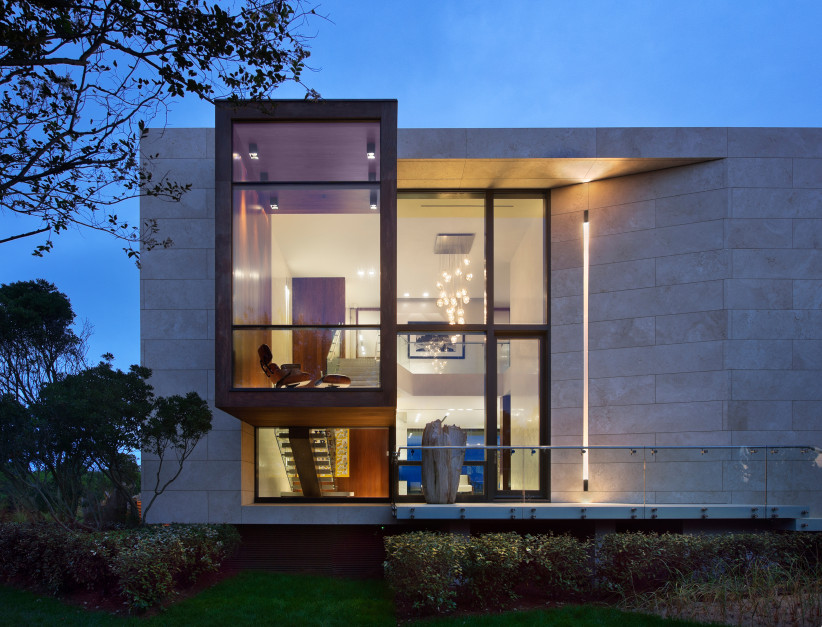
===============================================================================
Architecture Award / Architecture
Stelle Lomont Rouhani Architects
Project: Shore House

Nestled behind the dunes in Amagansett, this 3000sf residence is designed to take advantage of the spectacular site while being sensitive to the natural landscape surrounding it. Conceived of as two offset stacked boxes, the first floor steps away from the landscape creating a private outdoor sitting area that is defined by the cantilevered volume above and the dunes. Three guest bedrooms with associated baths, a large media room and building services make up the lower level. The bedrooms, while modest in size all have outdoor access leading directly to the dune path and the beach.
An exterior staircase curtained by a wooden screen leads to both the second floor and the roof deck. The main living space is located on the second floor to capture the ocean view. The space contains cooking, eating, and living functions all in one room. 11ʼ x 11ʼ stackable sliding doors open the space up completely to the deck that is created by the volume below. The fireplace captures two of these sliding panels, turning the room into one large outdoor porch. The master bedroom and master bath are found on the roadside of the second story, adequately screened by the wooden slats and vegetation.
Due to height restrictions, the entire roof could not be turned into a roof deck. By lowering the ceiling over the master bedroom, master bath and entry, a portion of the roof was lowered enough to create space for a spa and outdoor shower overlooking the ocean.
Driven by the clients to create as sustainable a house as possible, exterior mounted moveable wooden screens were designed to cut out the southern sun. A geothermal system is used for cooling and heating, and photovoltaic panels are employed on the roof to offset the electrical load. The remainder of the upper roof is vegetated to further reduce the heat load and to give back to the environment.
The exterior skin is a combination of zinc panels and red cedar siding. The interiors were a collaborate effort with the clients who are interior designers known internationally for restaurant and retail design.
Credits & Contact Information listed at end of Album
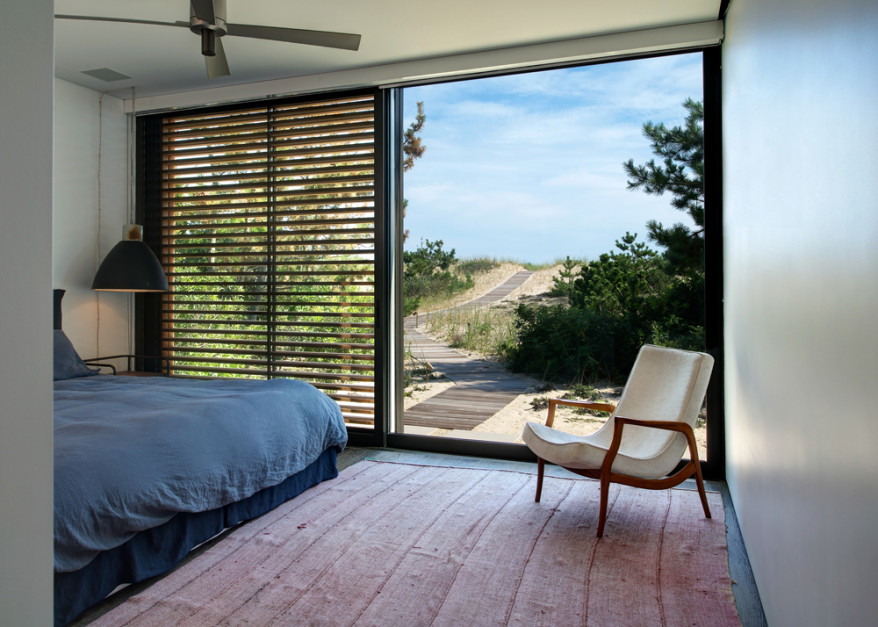
===================================================================================
Honor Award / Architecture
Bates + Masi Architects
Project: Mothersill
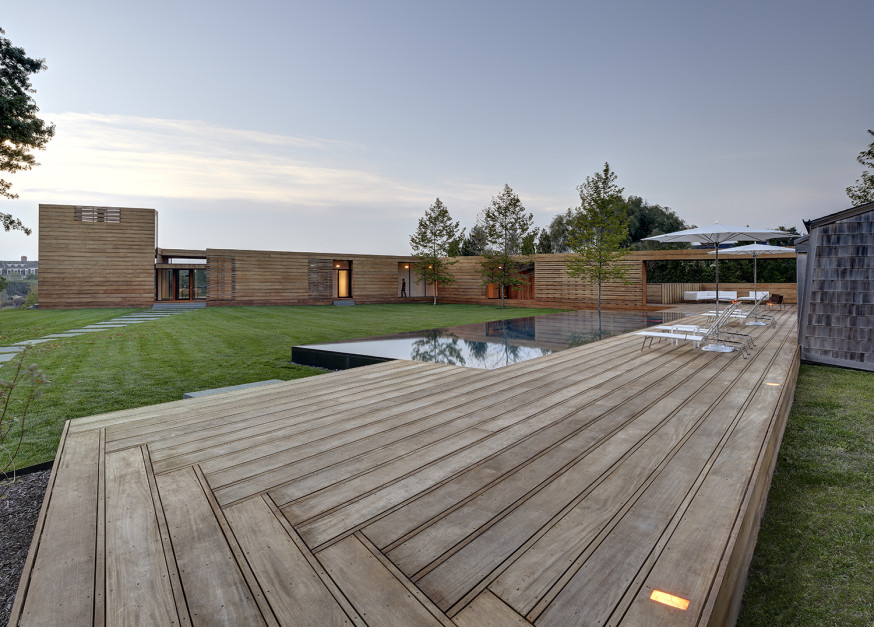
Elevated, wooden boardwalks extending into the beachscape are a common occurrence in the dunes of Eastern Long Island. Hovering slightly over the ground, this simple device is a pathway to the beach that carefully negotiates a constantly changing terrain. Their simple construction challenges the extreme natural elements found at the intersection of land and sea. In beachfront construction, the boardwalk provides a unifying accessibility that connects disparate elements of building and landscape; it is an extension of building that is knit within the landscape. This design for a vacation home in Water Mill, New York, utilizes a boardwalk as an architectural device for weaving together multiple portions of a historic site with new building and landscape elements.
Located on a creek-front property, the site contains two culturally significant structures designed by architect Andrew Geller and a diversity of landscape plantings. The two Geller structures, a small house and studio, were built in 1962. Common to Geller’s architecture, a boardwalk extends from the two structures to provide a connection between the two. A varied collection of botanically significant plantings populates the property, including a rare specimen Yew garden, serpentine Yew, and more than 400,000 Siberian Iris. The western edge of the property slopes downward to a low-lying wetland bordering the creek. A conservation easement on the property protects the two Geller structures, Yew garden and iris, while allowing for the addition of a new main house. The owners of the property requested a design that seamlessly incorporated the protected Geller structures, Yew garden, and new residence. To achieve this objective, a constructed path traverses the site to link visual and spatial relationships between these elements. The path takes the form of a raised, wooden surface that recalls the boardwalks of Geller’s architecture.
Similar to the way the boardwalks in nearby dunes engage an undulating landscape, this low, horizontal path engages distinct site features with the historic Geller structures and new house. Building and wetland setbacks, existing landscape features, site access, and conservation easement restrictions overlap to create the parameters of a meandering path across the site. The path originates from the relocated Geller House in the Yew garden and winds around the serpentine hedge to a new swimming pool. Like the historic arrangement of the Geller House and Studio, the new boardwalk physically connects the two historic structures. As the path continues it passes the Geller Studio, now reprogrammed as a pool house, and connects to shaded outdoor living spaces. A new central lawn is defined as the boardwalk wraps to extend through the main house. A cantilevered deck wraps the end of the main house at the termination of the path, providing views of the sloping wetland and creek. The surface of the path folds up and over to become the enclosure of the main house, simultaneously functioning as floor, wall, and roof. All surfaces of this enclosure are constructed with the same wood decking as the boardwalk. Their uniformity gives the effect of a single envelope containing a variety of parts and reflects the influence of design in Geller’s work. In these ways the physical, material, and spatial qualities of the path facilitate an architectural dialogue between the Geller structures and new house that is interwoven with the existing landscape, collecting the once individual elements into a unified whole.
Credits & Contact Information listed at end of Album

===================================================================================
Honor Award / Architecture:
Bates + Masi Architects
Project: Sagaponack
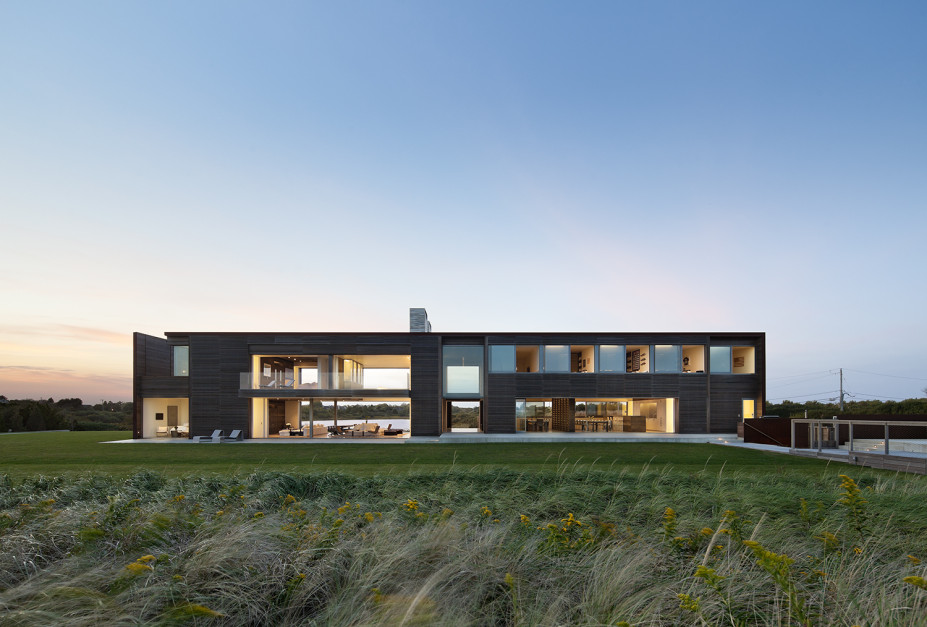
Located between the Atlantic Ocean and a freshwater pond, this residence is for an adventurous couple and their four sons. They wanted a house for their large family and numerous guests with a lawn, swimming pool, pool house, garage, and sports courts on a site with a limited building envelope due to coastal and wetland zoning. The large program, relatively small footprint, and daunting regulations dictated a building envelope densely packed with program that stood as a barrier between the ocean and the pond. Thus the design process was one of subtraction rather than addition: carving away at the solid mass of the house to reconnect site features and views and to distill the experience of the place.
Spaces run the full width of the house with floor to ceiling sliding doors on both sides. The spaces create apertures through which views, light, and air completely penetrate the house, dissolving its mass. Passersby see directly through the house to the sky and landscape beyond. With the sliding doors open and recessed into the adjacent walls, interior spaces are transformed from formal rooms to open pavilions, merging seamlessly with the site.
The plinth of the elevated house is carved into a series of stepped planters that are further sculpted into the entry steps, mediating the different grades required by flood control regulations. Besides dictating the minimum first floor height, regulations also set the roof height. To maximize the ceiling heights within those limits, the house utilizes a steel moment frame to pare down the thicknesses of the floors and roof to the absolute minimum.
The design strategy to accommodate the extensive program is to nest spaces within one another. Operable partitions pull out from the walls of the living room, carving out a media room within the living room when privacy is desired. Conversely, with the partitions open, the media room merges with the living room for large gatherings. The thickness of the wall separating the dining room and kitchen is also cut away, utilizing its depth to accommodate a wine rack that also functions as a light fixture.
The process of carving is applied at the material and detail level as well. The 5/8” corten steel plate that clads the base of the house is waterjet cut into a delicate pattern that defies its mass. Inside, corian is employed for the ease with which it can be milled. Corian countertops are cut to form towel bars, bunk bed frames are carved to create ladders, cabinet doors are recessed to form handles, and wainscoting is subtly etched with meaningful words chosen by the clients.
Materials were chosen not only for their workability, but also for their durability in the harsh coastal environment. Heavy gauge corten steel siding is zero maintenance in spite of being relentlessly sandblasted by the wind. Cedar siding and screens are finished using a Victorian technique in which the iron sulfate in a blend of white vinegar and iron filings reacts with the tannins in wood, creating an ebony finish that penetrates through the material and will not require refinishing. The lack of harsh stains or finishes reduces the ecological footprint of the house. Geothermal heating and cooling as well as vegetated roofs further reduce the environmental impact.
Using the design approach of sculpting away rather than building up, the house is pared down until the experience of the extraordinary site is dominant.
Credits & Contact Information listed at end of Album
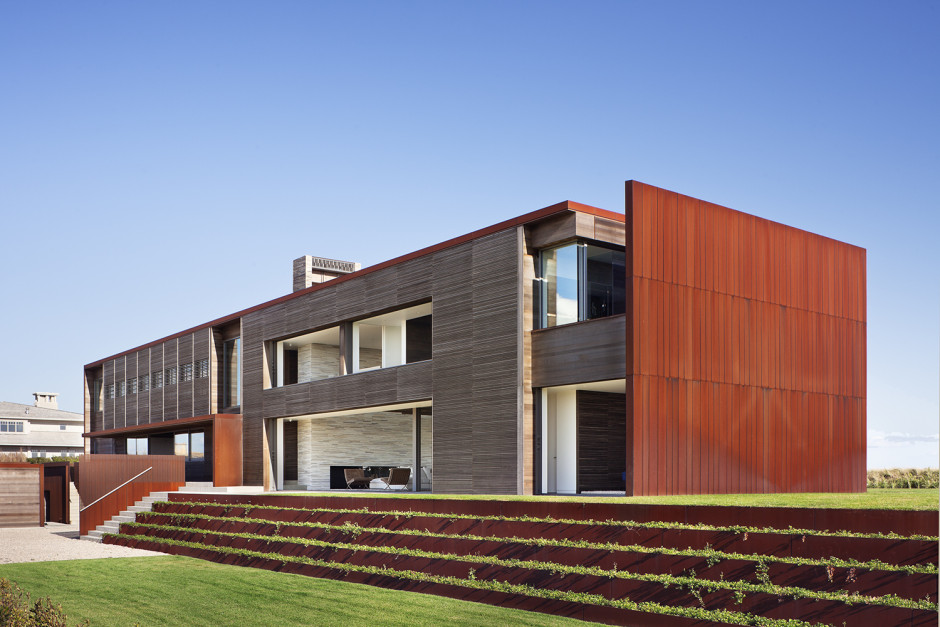
=================================================================================
Juror Award / Project
Hideaki Ariizumi & Glynis Berry
Project: Greenport Eco-Energy Park Conceptual Design
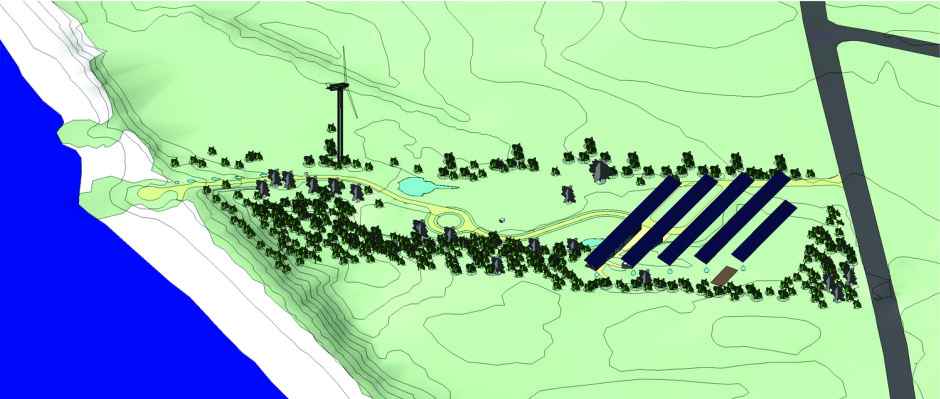
This project is a conceptual visualization for the Village of Greenport’s initial proposal for an Eco-Energy Park on an 8.7 acre parcel. The site currently contains the Village outfall pipe from its sewage treatment plant. The first goal of the project is to build a self-generated energy system to replace the costly, open-market purchases of additional electrical power made when demand exceeds the limits of a hydro-generation contract. Renewable energy generation from solar, wind, and eventually tidal installations will be designed to supplement the hydroelectric power purchases.
The second goal is to develop the site as a public park, educational facility, conference center, and demonstration site for a range of sustainable and green infrastructure practices. Designed as an amenity providing public access to the Long Island Sound, the restored site will enhance this underused waterfront parcel and serve a wide audience, including the local populous and visitors. Trails will link this facility to other public lands including a Bay-to-Sound trail system, providing access to a full range of natural environments. The site will be developed for delight and exploration as well as utility, serving as an eco-tourism attraction on the East End. The social, economic and environmental priorities of the triple bottom line will all be advanced by this project.
Our visualization proposes the followings: Preservation and emphasis on existing character of the terrain. Site improvements will be applied passively, such as replacement of invasive plants with native, removal of debris, bluff protection enhancement at the base of the cliff face, and restoration of vernal wetland area. Functional access for maintenance and fire truck access uses stabilized permeable materials, and designed to enhance a sequential experience from land to sea. Rain gardens for stormwater run‐off control, water retention for reuse, a wetland for daylighting sewer outfall for further nitrogen removal, and a gray-water treatment marsh will add functional water features on the site. Natural and artistic interventions underlying the park’s theme, such as living bridge/fences, boardwalk, micro‐wind sculpture, and “dark sky” lighting/reflective installations will be installed site specifically.
Themed trails centered on concepts related to the Sun, Earth, Wind and Water. Educational components will be categorized and restructured along the themed trails. Examples of sustainable approaches applicable to domestic scales will be showcased along the relevant trails.
Consolidating structures and site. Adopting the existing site terrain, the education/conference center and public bathrooms with a community gallery/pavilion will be half-submerged into the existing hill, which reduces the visual impact of new construction on the site. Public bathrooms use composting, urine collection, gray water systems and/or other innovative wastewater treatment. 40 parking spaces include a solar charging station for electric vehicles, bicycle rack, and permeable pavement. All of these structures will be tucked under or attached to the solar panel rows. The visual impact to the site will be minimized. The site and structures will be integrated.
Themed cabins — The camping facilities include cabins corresponding to the trail themes. Themed cabins explore the impact of green inspirations on buildings and spaces. “Sundial cabin” casts a varying slit of light on the interior relating time and seasons to solar resources. “Folded terrain cabin” incorporates a green roof. “Chimney cabin” emphasizes the chimney affect as natural ventilation. “Water harvesting cabin” collects and reuses rain water.
Credits & Contact Information listed at end of Album

==========================================================================
Merit Award / Architecture
Marmol Radziner
Project: Bull Path Residence
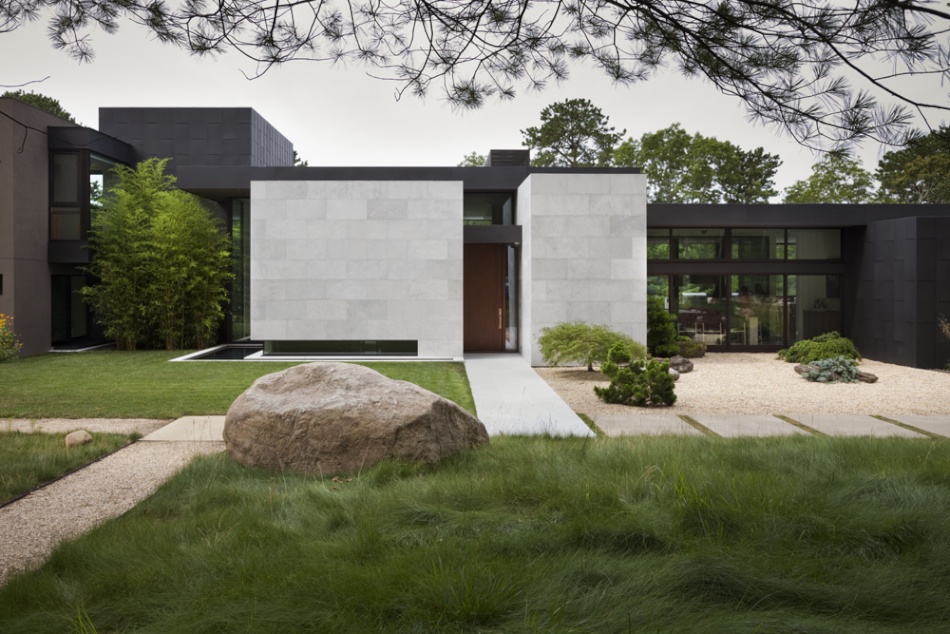
Situated in the Hamptons in an area heavily forested with white pines and oaks, the Bull Path Residence is located on a gently sloping site at the top of a hillside.
From the street, the exterior profile is horizontal and unobtrusive. Upon entering the house, the layering of the interior volumes becomes apparent and the house opens up to expansive views of the surrounding forest. Looking across the pool terrace and garden, vistas of the landscape are framed by windows and the wings of the house. In contrast to the surrounding forest, the house and central raised pool terrace are conceived as refined elements hovering above the untamed landscape.
Living, dining, and kitchen areas of the house are flanked on either side by two private wings: one bedroom wing and one guest bedroom suite. Floor-to-ceiling glass and double-height spaces accentuate the verticality of the forest. A sunken library offers space for reading and quiet contemplation. On the upper level, the master bedroom opens onto an exterior terrace that looks out over the tree canopy. On the lower level, there is a spa, game room, media room, and wine room. Exterior materials include Italian stone cladding and glass windows and doors framed in black anthracite zinc. Horizontal roof planes extend beyond the building envelope, creating covered spaces for exterior living at all times of year.
Credits & Contact Information listed at end of Album
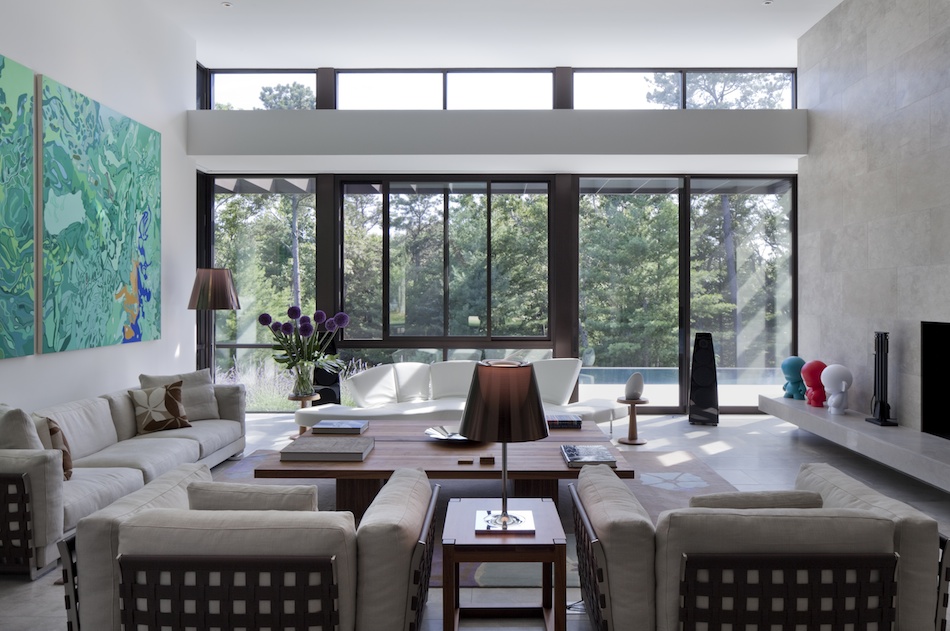
===================================================================================
Juror Award / Project:
Maziar Behrooz Architecture
Project: Illumination Center, New Orleans

Illumination Centers (IC) are a project of the Youth Rescue Initiative (YRI), the New Orleans Public Library Foundation (NOPLF), and the New Orleans Public Library System (NOPLS).
The goal of the Illumination Center Project is to bridge the digital divide that prevents many in low income neighborhoods from taking full advantage of the offerings of modern technology and to provide structured educational programming through the NOPLS.
Each center will have one to two recycled shipping containers that are retrofitted with computer work stations and networked to the New Orleans Public Library. Library staff will monitor each center and guide students to use various educational software for resume building, job search, homework assistance and general research. Conceived as the first in a series, the learning lab will offer a safe zone for school-aged children (ages 12-17) and members of the surrounding community to access the internet and learn how to navigate and utilize other digital media.
The sites that the centers occupy are urban, small and residential with nearby access to bus stations, libraries and schools. Each center will have an overhead canopy, derived from the floral patterns of French Quarter balcony grills. Eventually these will be covered with native New Orleans flora and fauna and create a shaded outdoor space for use by neighborhood residents as well as students.
One of our design objectives was to explore extreme cost effectiveness, which determined the use of shipping containers. Our challenge was to ensure that the space within each would be pleasurable and accommodating.
The curving of the corners was a means to remove the perception of boundary and thus create a sense of spaciousness within a small space. The end walls of the containers are completely removed and replaced with operable doors and windows. The resultant view through will allow outdoor space to be brought into the experience within and provide for a more fluid interaction between the activities inside and outside.
The YRI’s goal is for the pilot Illumination Center to be the first in a series of many that will serve various communities in the City of New Orleans.
Upon the completion of construction and landscaping, the project will be handed over from the YRI to the NOPL and the lab will become an extension of the library system. As a part of the city-wide library system the lab will be linked to a dynamic array of software packages and access to databases from homework help to résumé development and interview coaching. To further provide a well-rounded program, NOPL plans to partner with local universities, including Tulane University and the University of Loyola New Orleans to provide after-school tutoring and programmatic support.
The goals of our partnership group are aligned with the City’s objective of improving the future of New Orleans’ “Next Economy.” Our collective vision is achievable through the type of innovative and collaborative approach represented in the Illumination Center.
The following pages show a typical example of one center on a typical site in New Orleans.
Credits & Contact Information listed at end of Album
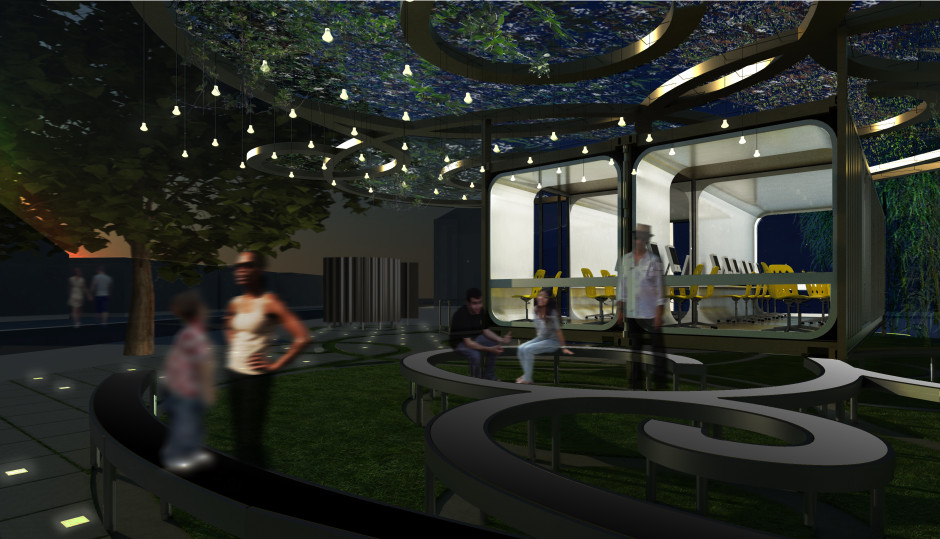
===================================================================================
Honor Award / Architecture
James Merrell Architects
Project: Amagansett Lanes
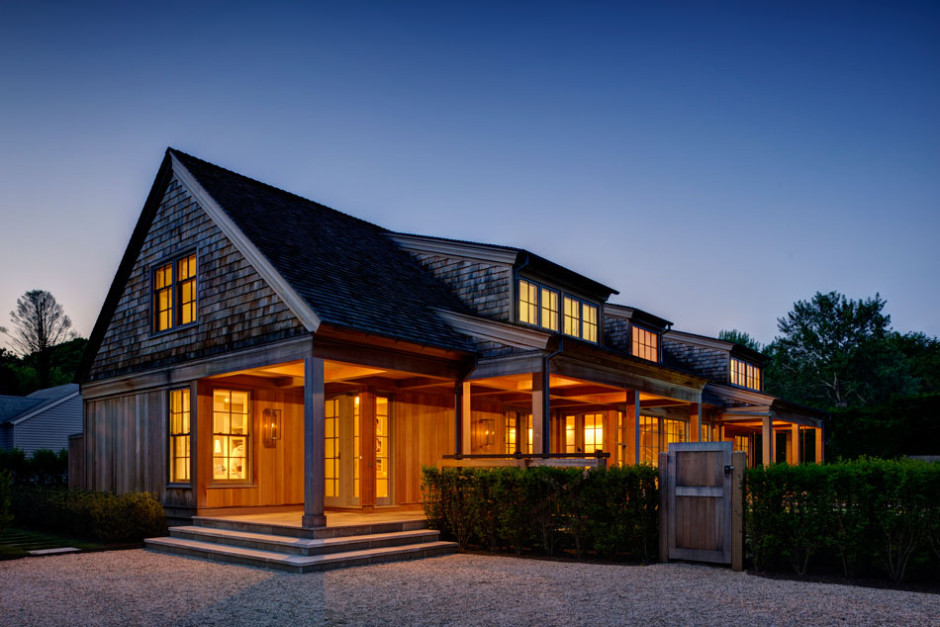 The Lanes in Amagansett have historically been a cottage-scaled community; however, recent residential development has begun to overshadow the local vernacular. Positioning the house perpendicular to the street allows the home to meet the client’s needs while maintaining a modest facade towards the Lanes.
The Lanes in Amagansett have historically been a cottage-scaled community; however, recent residential development has begun to overshadow the local vernacular. Positioning the house perpendicular to the street allows the home to meet the client’s needs while maintaining a modest facade towards the Lanes.
The main circulation path of the home runs along the south elevation, bookended by the main entry to the west and master suite to the east. This axial circulation acts as a spine between indoor and outdoor spaces.
Covered porches extend from the circulation path, allowing for abundant natural light in the winter while providing necessary shade from the hot summer heat. At the center, the porch overhang breaks to allow for increased sunlight into the double height living and dining room. This central space acts as the family cabin; an open living space for the client’s modern lifestyle. Operable windows and doors facing the yard provide a flow of fresh air and blur the boundaries between indoor and outdoor rooms.
Anchoring the pool onto the house provides a calming water feature for dinner parties as well as an unobstructed view of the yard during active summer pool parties. Accessory buildings bound the yard to give focus to the outdoor living space.
Credits & Contact Information listed at end of Album
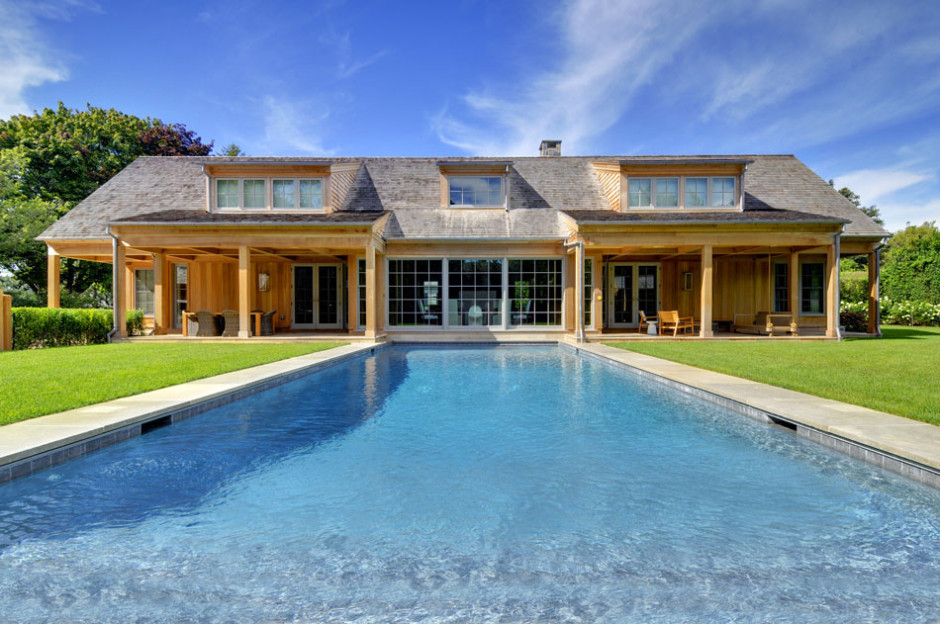
=======================================================================================
Merit Award / Architecture
James Merrell Architects
Project: Idaho House
========================================================================================
Merit Award / Architecture
Blaze Makoid Architecture
Project: Bull Path
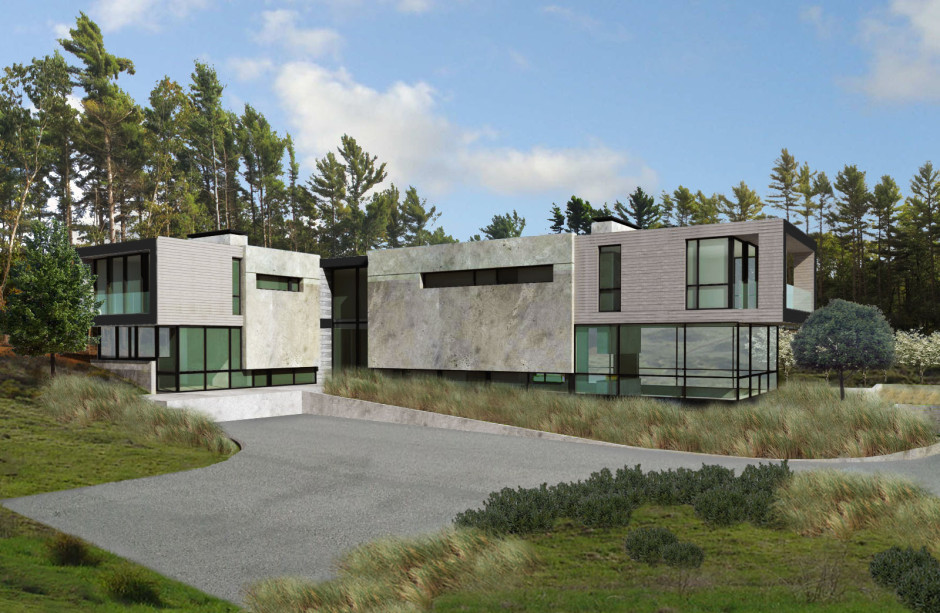
This 6,200 square foot house in East Hampton is situated on a long, two acre site that is steeply sloped along the eastern property line. The property is heavily wooded with mature pine trees.
Large walls of floating stone panels are incorporated at the approach to the house creating a level of monumentality as well as providing privacy to the street and guest parking. Behind these two panels resides a pair of two story volumes oriented in an offset ‘T’ configuration. A two story glass entry link frames the distant views across the length of the property via a 12 foot by 75 foot reflecting/swimming pool. This configuration is meant to cradle the built outdoor spaces as well as a play lawn while maximizing daylight and southern exposure in what is otherwise a densely shaded site. The east/west volume contains an open plan living room, dining room and kitchen at the ground level with a master suite on the second floor. The column free leg of the north/south volume is made up of an outdoor living and dining space which is sheltered from the elements by the second floor children’s bedrooms. This wing is supported by a fifty five foot beam resting on a single ‘super column’, hidden within the outdoor bath. A guest suite, home office and family den round out the above grade program.
The residence also contains an extensive subterranean level that extends far beyond the footprint of the first two floors and provides patio, terrace and garden space at the first floor level. This lower level houses more lively and boisterous activities, including a children’s playroom, gym, home theater, game room, and home bar that opens onto a private patio bordered by a water wall from the pool above.
Completion is planned for the summer of 2014.
Credits & Contact Information listed at end of Album

=======================================================================================
Juror Award / Project
John David Rose Architect, P.C.
Project: Next Generation Housing
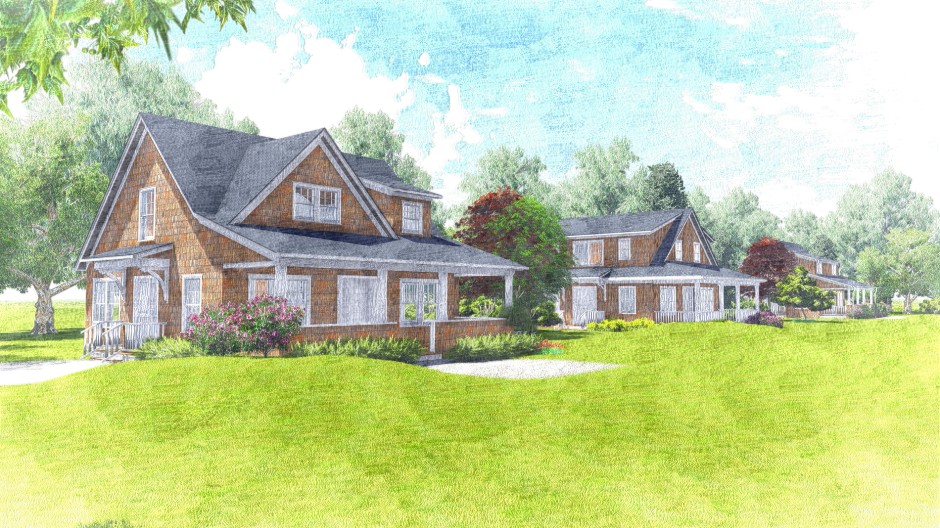
The Next Generation Housing Project is an exciting, most worthy program that literally exemplifies the saying “It takes a whole village.” The village used a lottery system whereby applicants would be selected to buy their homes. These applicants are first responders within Southampton Village who otherwise must live further away, therefore increasing emergency response time.
Suffolk County through a tax lien transferred the land to the Village of Southampton with the condition that it would be used to build Affordable Housing. This land has resulted (after much diligent effort) in three buildable lots on Bailey Road.
As Mayor Mark Epley stated in a recent news article “This is one of the great reasons why Southampton is such a great place to live. Because of the pure volunteer spirit that exists in the community.” And volunteer we all did! Everything from architecture to the financing and so much in between–a list has been attached for your review. This project has even gone as far as providing I.D.P. credits to two of our intern architects for the construction document phase. So many aspects of Southampton Village has been touched in a positive way, this project is much more far reaching than I could imagine.
It is the hope and intent that this will be a “blueprint” for other municipalities to follow. It is also a meaningful way for local businesses to give back to a village that has afforded them such boundless opportunity for success.
Credits & Contact Information listed at end of Album
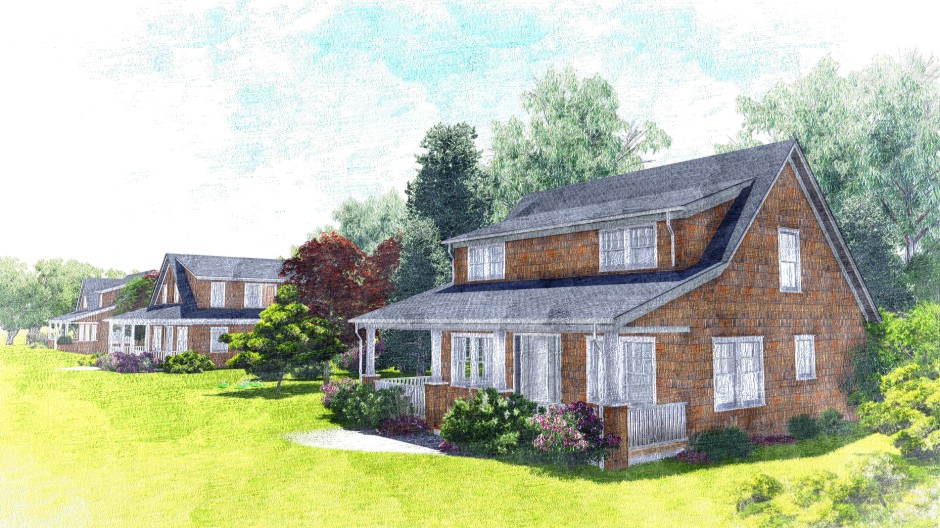
======================================================================================
![]()
_________________________________________________________________________________
AIA Peconic 2013 Architecture Awards Jurors:
Eric Goshow, AIA Goshow Architects – 2013 President, AIA New York State, Kim Yao, AIA Architectural Research Office and Jordan Gruzen, FAIA from Gruzen Samton Architects.
__________________________________________________________________________________
ARCHITECTS — CONTACT INFORMATION — CREDITS
————————————————————————————————————
Architecture Award / Architecture
Blaze Makoid Architecture
Project: Daniel’s Lane
www.blazemakoid-architecture.com
![]()
Architect: Blaze Makoid Architecture — Structural, M/E/P and Sanitary: Condon Engineering, P.C. — Environmental Permitting: Inter-Science Research Associates — Surveyor: Squires, Holden, Weisenbach & Smith.
===========================================================================
Architecture Award / Architecture
Stelle Lomont Rouhani Architects
Architect: Stelle Lomont Rouhani Architects — Design Team: Frederick Stelle, Viola Rouhani, Jonathan Subject, Lucas Cowart — Interior Design: Yabu Pushelberg — General Contractor: Brian Mannix Builder — Landscape Architect: La Guardia Design — Photographer: Matthew Carbone.
=========================================================================
Honor Award / Architecture:
Bates + Masi Architects
Project: Sagaponack
www.batesmasi.com

=======================================================================
Juror Award / Project
Hideaki Ariizumi & Glynis Berry
Project: Greenport Eco-Energy Park Conceptual Design
www.studioabarchitects.com

Architecture/Design Team: Hideaki Ariizumi, Glynis Berry — Images: Hideaki Ariizumi — Client: Village of Greenport.
===================================================================
Merit Award / Architecture
Marmol Radziner
Project: Bull Path Residence
www.marmol-radziner.com
![]()
Project team: Leo Marmol, FAIA, Managing Principal and Ron Radziner, FAIA, Design Principal — Project Manager: Matt Jackson — Design Associate: Stephanie Hobbs.
======================================================================
Juror Award / Project:
Maziar Behrooz Architecture
Project: Illumination Center, New Orleans
www.mbarchitecture.com
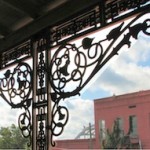
============================================================================
Honor Award / Architecture
James Merrell Architects
Project: Amagansett Lanes
www.jamesmerrellarchitects.com

Project Architect: Jason Atkins — Architecture Team — Adam Volosik, Aaron Proulx — Interior Design: Leslie Martinez — General Contractor: Cardel Development — Structural Engineer: Steven L. Maresca — Landscape Architect: Brandy Anderson — Photographer: Matthew Carbone.
=============================================================================
Merit Award / Architecture
James Merrell Architects
Project: Idaho House
www.jamesmerrellarchitects.com

===============================================================================
Merit Award / Architecture
Blaze Makoid Architecture
Project: Bull Path
www.blazemakoid-architecture.com
![]()
Architect: Blaze Makoid Architecture — Structural, M/E/P and Sanitary Engineering: Condon Engineering, P.C. — Surveyor: Saskas Surveying Company, P.C. — General Contractor: McLoughlin Construction — Landscape Architect: Landscape Details.
==============================================================================
Juror Award Project
John David Rose Architect, P.C.
Project: Next Generation Housing
www.johndavidrosearchitect.com

Architect: John David Rose, P.C. — Project Team: Ryan Berry, Paul Dula, Billy Imperiale, Donna Kober, John Rose, Scott Rose. And: Bill Clair Excavating — Bourke, Flanagan & Asato, P.C. — Bruce A. Peterson Irrigation — DeLalio Coal & Stone — East End Glass & Mirror — Edmund Hollander Design, P.C. — G.Craig Electrical — H.F.Swanson Construction — Ironwood Construction — J. Tortorella Group — Kolb Mechanical — Nugent & Potter, Inc. — Old Town Crossing — Precision Excavating — Revco Supply — Riverhead Building Supply — Speonk Lumber Supply — Steve Maresca & Associates — Suffolk County National Bank — Suffolk Lighting Supply — The Luss Group — Tim Blenk Tree Care — Village Cheese Shop.
___________________________________________________________________



